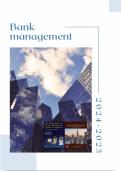SAMENVATTING BANKMANAGEMENT
MARTIEN LAMMERS 2024-2025
,CHAPTER 1: WHAT ARE BANKS?
Banks are specialized financial institutions that hold a distinct place in the economy. Banks are financial
institutions central to the functioning of the economy, offering a broad spectrum of financial services that benefit
individuals, businesses, and governments, thereby supporting wealth management, transactions, lending, and
economic development. They are unlike typical businesses or manufacturing firms, and their nature and
functions will be explored in detail starting here.
1.1 WHAT ARE BANKS?
What do we use banks for?
1. Save our money
• Store of wealth (savings accounts)
2. Use our money
• Payment methods (checking account, debit/credit card, Bancontact, mobile banking, currency
exchange, …)
3. Source of credit
• Mortgage, personal loan, car loan, student loan, business loan, …
4. Invest
• Term accounts, bonds, equities, pension saving, funds, …
5. Insurance
• Car insurance, life insurance, family insurance, travel insurance, …
Banks serve many purposes, including safeguarding savings, facilitating everyday payments, and providing access
to credit through loans. They also offer investment opportunities—such as bonds, equities, and pension
savings—and can provide insurance services, either directly or through associated companies.
Quick Reminder
Unlike ordinary service or manufacturing firms, banks operate under a fundamentally different business model,
dealing primarily with financial products, assets, and liabilities rather than tangible goods. Assets represent
everything owned, liabilities represent everything owed, and their difference constitutes equity. This
fundamental accounting principle underpins the structure of any balance sheet, including that of a bank.
2
,Bekaert balance sheet
The balance sheet of a non-financial firm, like Bekaert, primarily comprises tangible and intangible operating
assets such as factories, inventories, receivables, and cash. These elements reflect the firm's productive activities
and investment in real economic operations. Bekaert's top three balance sheet components include factories,
inventories, and cash or cash equivalents, funded through interest-bearing debt (both current and non-current
liabilities) and trade payables.
What are banks?
Banks are different compared to a regular service or manufacturing firms
A bank balance sheet looks very different
• Instead of “real assets”, it has financial assets
Belfius balance sheet
In contrast to Bekaert, a bank's balance sheet, such as Belfius, fundamentally differs in asset structure as it mainly
consists of financial instruments—cash at central banks, interbank loans, lending to customers, securities,
derivatives, and limited tangible/intangible assets—reflecting its core role in financial intermediation rather than
physical production. In liability structure as they are mainly deposits from customers and other borrowed funds,
along with issued bonds, subordinated debt, and financial instruments. Insurance-related obligations and tax
liabilities may also appear, reflecting the diverse funding and obligation structure of a financial institution.
3
, Bank Balance Sheet
Banks (and other financial institutions) have a different asset and liability structure compared to other firms
1. Funded by financial liabilities:
• Deposits
• Bonds
• Subordinated debt
• (Equity capital)
2. Assets are also (mainly) financial:
• Cash
• Loans
• Securities
• Fixed assets
Banks differ fundamentally in that both their assets and liabilities are predominantly financial. They rely on
deposits, bonds, and subordinated debt for funding and invest in loans and securities rather than substantial
physical, production-related assets. Hence we see that Fixed assets which include bank buildings (branch offices)
are only 5%, meanwhile 60-70% are loans. A bank’s core structure features deposits, bonds, and equity funding
on the liabilities side, while the assets are predominantly loans, securities, and some cash reserves, with relatively
minor fixed assets. This arrangement underlies their role in financial intermediation.
Fixed assets
• Branch network
o ‘Brick and mortar’ → (meaning: locations—physical buildings where customers can go)
o Role used to be to attract new clients, wire transfer money
o Less necessary due to internet banking
o More based on giving advice (e.g., mortgages)
o In combination with fixed high costs, banks are closing down branches
Banks maintain costly brick-and-mortar branches as fixed assets. Historically, these locations attracted clients
and handled everyday transactions, but the rise of internet banking has reduced their necessity. Today, branches
focus more on advisory services like mortgages. High fixed costs and changing consumer behaviour have led to
widespread branch closures. Data and studies confirm a declining number of branches and the evolving role
these physical locations play in lending and client interaction.
(Extra: Nguyen (2019) finds that bank consolidation initially reduces small business loans and mortgages due to
disrupted relationships and integration challenges. Over time, lending may recover as merged banks stabilize
and optimize operations, with impacts varying by loan type and strategy.)
4





